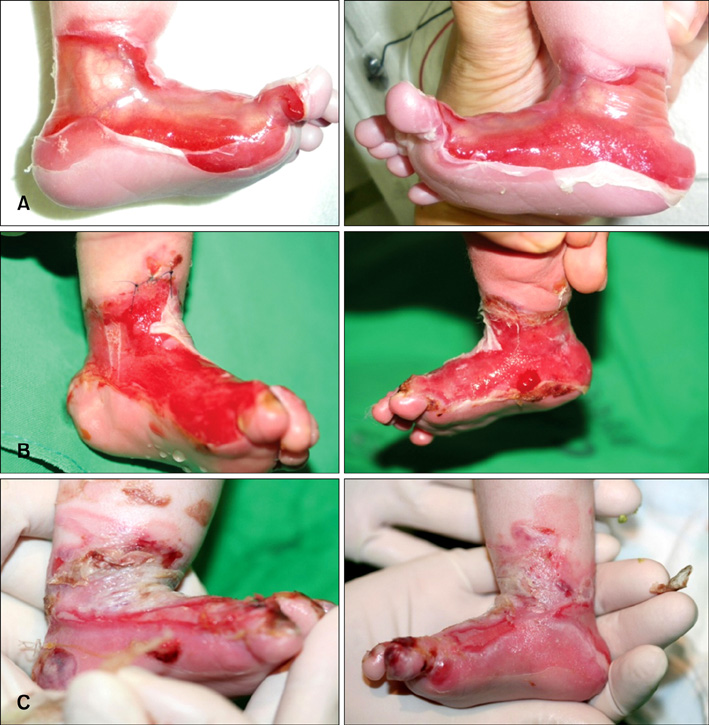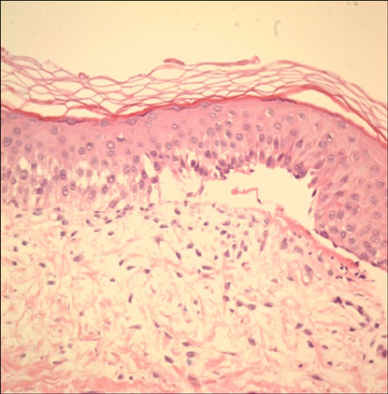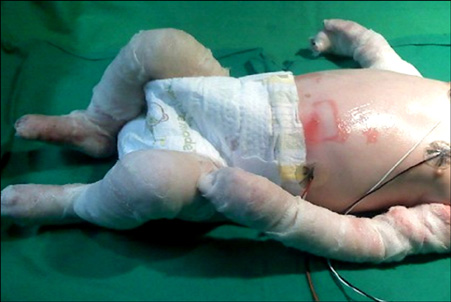Ann Dermatol.
2011 Dec;23(Suppl 3):S393-S397. 10.5021/ad.2011.23.S3.S393.
The Use of Cultured Allogenic Keratinocyte Grafting in a Patient with Epidermolysis Bullosa Simplex
- Affiliations
-
- 1Department of Plastic and Reconstructive Surgery, Chung-Ang University Hospital, Seoul, Korea. hkkiim@cau.ac.kr
- KMID: 2171881
- DOI: http://doi.org/10.5021/ad.2011.23.S3.S393
Abstract
- Epidermolysis bullosa (EB) is a rare genetic disease that is known for continuous skin blistering caused by minor trauma. The skin blisters and bullae that develop often cause skin defects. There is no definitive treatment for EB, only symptomatic relief. We report our experience with cultured allogenic keratinocyte grafting in a newborn patient with EB simplex who had unhealed raw surfaces and was not a skin grafting candidate. The skin lesions of the patient were covered with cultured allogenic keratinocyte grafts and re-epithelialized quickly with no scarring. Allogenic keratinocyte grafting reduced pain and produced noticeable improvements in the unhealed wounds. We think that allogenic keratinocyte grafting can play an important role in the management of patients with EB simplex.
MeSH Terms
Figure
Reference
-
1. Coulombe PA, Kerns ML, Fuchs E. Epidermolysis bullosa simplex: a paradigm for disorders of tissue fragility. J Clin Invest. 2009. 119:1784–1793.
Article2. Sawamura D, Nakano H, Matsuzaki Y. Overview of epidermolysis bullosa. J Dermatol. 2010. 37:214–219.
Article3. Horn HM, Tidman MJ. The clinical spectrum of epidermolysis bullosa simplex. Br J Dermatol. 2000. 142:468–472.
Article4. Lara-Corrales I, Arbuckle A, Zarinehbaf S, Pope E. Principles of wound care in patients with epidermolysis bullosa. Pediatr Dermatol. 2010. 27:229–237.
Article5. Sprecher E. Epidermolysis bullosa simplex. Dermatol Clin. 2010. 28:23–32.
Article6. Denyer JE. Wound management for children with epidermolysis bullosa. Dermatol Clin. 2010. 28:257–264.
Article7. Williamson D, Coutts P, Sibbald RG. The role of dermal skin substitutes in the management of hard to heal unusual wounds. Can J Plast Surg. 2002. 10:27A–30A.8. Hasegawa T, Mizoguchi M, Haruna K, Mizuno Y, Muramatsu S, Suga Y, et al. Amnia for intractable skin ulcers with recessive dystrophic epidermolysis bullosa: report of three cases. J Dermatol. 2007. 34:328–332.
Article9. Pai S, Marinkovich MP. Epidermolysis bullosa: new and emerging trends. Am J Clin Dermatol. 2002. 3:371–380.10. Rheinwald JG, Green H. Serial cultivation of strains of human epidermal keratinocytes: the formation of keratinizing colonies from single cells. Cell. 1975. 6:331–343.
Article11. O'Connor NE, Mulliken JB, Banks-Schlegel S, Kehinde O, Green H. Grafting of burns with cultured epithelium prepared from autologous epidermal cells. Lancet. 1981. 1:75–78.12. Compton CC, Hickerson W, Nadire K, Press W. Acceleration of skin regeneration from cultured epithelial autografts by transplantation to homograft dermis. J Burn Care Rehabil. 1993. 14:653–662.
Article13. Braye F, Pascal P, Bertin-Maghit M, Colpart JJ, Tissot E, Damour O. Advantages of using a bank of allogenic keratinocytes for the rapid coverage of extensive and deep second-degree burns. Med Biol Eng Comput. 2000. 38:248–252.
Article14. Sauder DN, Carter CS, Katz SI, Oppenheim JJ. Epidermal cell production of thymocyte activating factor (ETAF). J Invest Dermatol. 1982. 79:34–39.
Article15. Lavker RM, Sun TT. Heterogeneity in epidermal basal keratinocytes: morphological and functional correlations. Science. 1982. 215:1239–1241.
Article16. Lavker RM, Sun TT. Epidermal stem cells. J Invest Dermatol. 1983. 81:1 Suppl. 121s–127s.
Article
- Full Text Links
- Actions
-
Cited
- CITED
-
- Close
- Share
- Similar articles
-
- A Possible Case of Epidermolysis Bullosa Simplex with Mottled Pigmentation
- A Case of Koebner Variant of Epidermolysis Bullosa Simplex
- A Case of Epidermolysis Bullosa Simplex ( Dowling - Meara Type )
- Dominant Dystrophic Epidermolysis Bullosa
- Two Cases of Epidermolysis Bullosa Simplex (Dowling-Meara Type)




